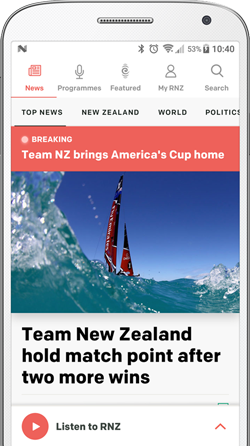
Flooding in Vanguard Street, Nelson on Monday. Photo: Supplied / Steve Armour
The mayor of Nelson has renewed calls for a rain radar to be installed in the region after flash flooding in the city.
Intense rainfall left parts of Nelson underwater on Monday. Streets and several homes and businesses were flooded, drains were overwhelmed, and emergency crews scrambled to respond.
Nelson Mayor Nick Smith said a rain radar at the top of the South Island would help give the city more warning about serious storms.
"Our problem is the closest rain radar is in Wellington, it's shadowed by the main range and as a consequence these events trap us quite nastily," he said.
"This was an event that yes we've had a warning that it was a relatively low level event, it turned out to be a lot more intense.
"We've been lobbying the Government both previous and current that that's an investment that needs to be made by the MetService... improving their forecasting so we can better cope with the sort of event we had yesterday."

Flooding in Nelson on Monday. Photo: Supplied / Valeriya Horyayeva
MetService said a new Nelson radar would cost $3 million and require a funding bid through the Crown's budget process.
"MetService is contracted by the Ministry of Transport to provide meteorological and related services that deliver safety benefits to New Zealanders," the agency said.
"Currently, we are not funded to provide a radar for the Nelson Tasman area, although we acknowledge it is one of several priority areas that we will continue to advocate for in future funding rounds."
MetService said a radar was just one of the many tools used by meteorologists to monitor the weather.
"Radar is most useful for a very accurate live picture of what is immediately happening at a place at a given time, and therefore what is likely to happen over the next hour or two depending on the range of the radar and where the weather is heading," it said.
"For effective response to severe weather events, much longer lead times are needed for warnings - preferably at least a day in advance. Radar pictures are in real-time so do not give this information.
"That said, any expansion of the observing network, such as new weather stations or radar facilities, assists our meteorological team build a more accurate picture of the current conditions across the country."
MetService said it had 10 weather radars around the country, the most recent addition being the Otago radar in 2020.
"In recent years, our major radar projects have involved the Wellington and Canterbury radars being upgraded due to their 30-year-old technology," it said.

Surface flooding remains in parts of Nelson after heavy rain hit the region on Monday. Photo: RNZ/Samantha Gee
Tasman District Council principal hydrologist Martin Doyle said the council had been pushing for a rain radar in the region since 2010, after a major flood in the Aorere Valley in Golden Bay.
It said a marine radar at a cost of $30,000 had been installed, which gave a visual output of heavy rain but no numerical data, so it could not be ingested into flood warning models.
Associate Transport Minister James Meager has been approached for comment.
The Brook Waimārama Sanctuary in Nelson said it was facing a bill of about $50,000 after flooding damaged its fence line.
The wildlife sanctuary was home to a number of endangered animals including 40 little spotted kiwi.
Chief executive Chris McCormack said the sanctuary was reeling from Monday's torrential rain.
"We still have a torrent of water coming through the sanctuary so just goes to show how much water is coming through the valley of the Brook Sanctuary," he said.
"Part of our fence line, about five to six metres wide, we had a gaping big hole under the fence which means that we had an opening into the sanctuary so a biosecurity issue. Our team of staff and volunteers have done an amazing job to rectify that for the short term but it's the longevity solution that we need to rectify," he said.
McCormack said the sanctuary was a not-for-profit organisation, and any donations from the community would be appreciated.

Flooding at the stormwater gates at the Brook Waimārama Sanctuary. Photo: Supplied/Brook Waimārama Sanctuary
Further south, State Highway 6 through the Lower Buller Gorge between Inangahua Junction and Westport remained close because of slips caused by heavy rain on Monday.
The Transport Agency advised motorists to use alternative routes via Reefton, Greymouth and the Great Coast Road.
"The team has now managed to fully assess the impacts to the road, and have identified a number of large debris flows, scour and rockfall that need to be cleared and made safe," it said.
"There has not been any damage to the road at this stage, but ongoing impacts will be monitored until water is redirected back into waterways, as well as assessing slope stability as the hillsides dry and stabilise."
Sign up for Ngā Pitopito Kōrero, a daily newsletter curated by our editors and delivered straight to your inbox every weekday.



